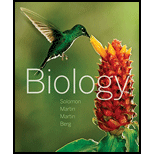
Concept explainers
Where is chlorophyll located in the chloroplast? (a) thylakoid membranes (b) stroma (c) matrix (d) thylakoid lumen (e) between the inner and outer membranes
Introduction: Photosynthesis is a process by which carbon dioxide and water are used to produce glucose molecules by using energy from sunlight. During this process, oxygen gas is evolved.
Answer to Problem 1TYU
Correct answer: The chlorophyll is located in the thylakoid membranes of the chloroplast. Hence, the correct answer is option (a).
Explanation of Solution
Reason for the correct answer:
Chloroplast is a double membrane bound organelle present in green plants and algae. The several reactions of the photosynthesis take place in the chloroplast of the plant cell that contains the green pigment chlorophyll. The chlorophyll is located within the thylakoid membrane of the chloroplast. The thylakoid membrane consists of two photosystem units: PSI and PSII. The thylakoid membrane separates the chloroplast into two compartments namely the chloroplast stroma and thylakoid lumen. These photosystem units absorb sunlight and pass it to an antenna molecule to drive the photosynthesis process.
Option (a) is given as “thylakoid membranes”.
The chlorophyll (green pigments) is found in the thylakoid membranes of the chloroplast.
Hence, the correct answer is option (a).
Reasons for incorrect answers:
Option (b) is given as, “stroma”.
The stroma is the fluid or aqueous layer which is enclosed by the inner membrane of the chloroplast. Chlorophyll is present in the thylakoid membrane, not in stroma.
Hence, option (b) is incorrect.
Option (c) is given as, “matrix”.
Matrix is a gel like substance present in the mitochondria, not in the chloroplast. Chlorophyll is present in the thylakoid membrane of chloroplast, not in the matrix.
Hence, option (c) is incorrect.
Option (d) is given as, “thylakoid lumen”.
The thylakoid membrane separates the chloroplast into two compartments: chloroplast stroma and thylakoid lumen (continuous aqueous phase). Chlorophyll is present in the thylakoid membrane, not in thylakoid lumen.
Hence, option (d) is incorrect.
Option (e) is given as, “between the inner and outer membranes”.
Chloroplast is a double membrane (inner and outer membrane) bound organelle present in green plants and algae. Chlorophyll is present in the thylakoid membrane, not in between the inner and outer membranes of the cell.
Hence, option (e) is incorrect.
Hence, the options (b), (c), (d), and (e) are incorrect.
Chlorophyll is located in the thylakoid membranes in the chloroplast.
Want to see more full solutions like this?
Chapter 9 Solutions
Biology (MindTap Course List)
- Explain how the hormones of the glands listed below travel around the body to target organs and tissues : Pituitary gland Hypothalamus Thyroid Parathyroid Adrenal Pineal Pancreas(islets of langerhans) Gonads (testes and ovaries) Placentaarrow_forwardWhat are the functions of the hormones produced in the glands listed below: Pituitary gland Hypothalamus Thyroid Parathyroid Adrenal Pineal Pancreas(islets of langerhans) Gonads (testes and ovaries) Placentaarrow_forwardDescribe the hormones produced in the glands listed below: Pituitary gland Hypothalamus Thyroid Parathyroid Adrenal Pineal Pancreas(islets of langerhans) Gonads (testes and ovaries) Placentaarrow_forward
- Please help me calculate drug dosage from the following information: Patient weight: 35 pounds, so 15.9 kilograms (got this by dividing 35 pounds by 2.2 kilograms) Drug dose: 0.05mg/kg Drug concentration: 2mg/mLarrow_forwardA 25-year-old woman presents to the emergency department with a 2-day history of fever, chills, severe headache, and confusion. She recently returned from a trip to sub-Saharan Africa, where she did not take malaria prophylaxis. On examination, she is febrile (39.8°C/103.6°F) and hypotensive. Laboratory studies reveal hemoglobin of 8.0 g/dL, platelet count of 50,000/μL, and evidence of hemoglobinuria. A peripheral blood smear shows ring forms and banana-shaped gametocytes. Which of the following Plasmodium species is most likely responsible for her severe symptoms? A. Plasmodium vivax B. Plasmodium ovale C. Plasmodium malariae D. Plasmodium falciparumarrow_forwardStandard Concentration (caffeine) mg/L Absorbance Reading 10 0.322 20 0.697 40 1.535 60 2.520 80 3.100arrow_forward
- please draw in the answers, thank youarrow_forwarda. On this first grid, assume that the DNA and RNA templates are read left to right. DNA DNA mRNA codon tRNA anticodon polypeptide _strand strand C с A T G A U G C A TRP b. Now do this AGAIN assuming that the DNA and RNA templates are read right to left. DNA DNA strand strand C mRNA codon tRNA anticodon polypeptide 0 A T G A U G с A TRParrow_forwardplease answer all question below with the following answer choice, thank you!arrow_forward
 Biology (MindTap Course List)BiologyISBN:9781337392938Author:Eldra Solomon, Charles Martin, Diana W. Martin, Linda R. BergPublisher:Cengage Learning
Biology (MindTap Course List)BiologyISBN:9781337392938Author:Eldra Solomon, Charles Martin, Diana W. Martin, Linda R. BergPublisher:Cengage Learning
 Biology: The Unity and Diversity of Life (MindTap...BiologyISBN:9781305073951Author:Cecie Starr, Ralph Taggart, Christine Evers, Lisa StarrPublisher:Cengage Learning
Biology: The Unity and Diversity of Life (MindTap...BiologyISBN:9781305073951Author:Cecie Starr, Ralph Taggart, Christine Evers, Lisa StarrPublisher:Cengage Learning Biology 2eBiologyISBN:9781947172517Author:Matthew Douglas, Jung Choi, Mary Ann ClarkPublisher:OpenStax
Biology 2eBiologyISBN:9781947172517Author:Matthew Douglas, Jung Choi, Mary Ann ClarkPublisher:OpenStax Concepts of BiologyBiologyISBN:9781938168116Author:Samantha Fowler, Rebecca Roush, James WisePublisher:OpenStax College
Concepts of BiologyBiologyISBN:9781938168116Author:Samantha Fowler, Rebecca Roush, James WisePublisher:OpenStax College Biology: The Dynamic Science (MindTap Course List)BiologyISBN:9781305389892Author:Peter J. Russell, Paul E. Hertz, Beverly McMillanPublisher:Cengage Learning
Biology: The Dynamic Science (MindTap Course List)BiologyISBN:9781305389892Author:Peter J. Russell, Paul E. Hertz, Beverly McMillanPublisher:Cengage Learning





